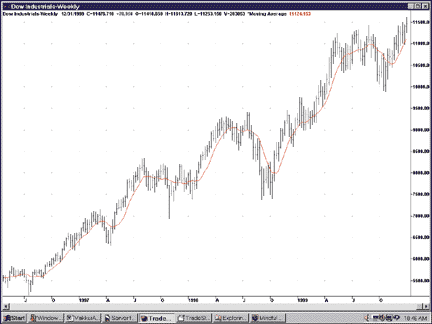VISUAL INSTRUCTION
Using Expert Commentary
by Mark Vakkur
One of the most neglected features of TradeStation is the ability to create and modify a study's Expert Commentary. And you don't have to be an expert to use it; if you can create a study, you can create expert commentary. This feature can add a new dimension to your chart analysis.
Used correctly, TradeStation commentary can jog your memory for important associations, point out interesting or unusual things in narrative text (instead of being a blip buried in a busy chart), and even serve as a substitute for TradeStation's data window, allowing you to see only the data you are most interested in and displayed in the format you want.

FIGURE 1: CREATING AN INDICATOR. The simple code written in the PowerEditor creates a moving average. The next commentary will be added to the indicator's code.
Further, you don't need to be a programmer to create powerful commentary -- although if you are a programmer, the sky's the limit. In fact, by cutting and pasting the code supplied here, you can be on your way to making and modifying your own TradeStation Expert Commentary in a few minutes. If you're really impatient, type in the code shown in the sidebar "Commentary code," get it running, and then go back to the article for explanation and elaboration about the elements that most interest you. The illustrations here are in TradeStation 4.0, but the code should work in TradeStation 2000i.
SOME BASIC DEFINITIONS
So what is Expert Commentary? In essence, it's a feature of TradeStation that allows you to point to any bar and summon a pop-up menu containing a descriptive interpretation of any indicator plotted. If you use the indicators that come with TradeStation, the interpretation provided is an explanation of how the user should put the indicator into the context of price action. Any software can calculate a simple moving average; truly advanced software can tell you or remind you what to do with it. If the close is above the moving average and the moving average is sloping upward (its value as of this bar is greater than its value as of the last bar), then you might get some text such as:
Simple Moving Average
Conventional Interpretation:
The price is above the moving average which is BULLISH.
Additional Interpretation:
The price is above the moving average and the moving average is sloping upward. This is VERY BULLISH.
You might think this is so obvious as to be useless, but it's not. To illustrate, I'll create some simple commentary that:
- Gives additional information about price (a customized data window)
- Tells if some condition we are looking for is present
- Is short and sweet.
For this exercise, I will use the moving average, but any indicator could be used.
Mark Vakkur is a psychiatrist and a stock trader. He can be reached via E-mail at mvakkur@hotmail.com, or via https://www.members.xoom.com/mvakkur/.
Excerpted from an article originally published in the March 2000 issue of Technical Analysis of STOCKS & COMMODITIES magazine. All rights reserved. © Copyright 2000, Technical Analysis, Inc.
Return to March 2000 Contents